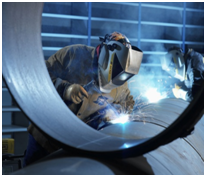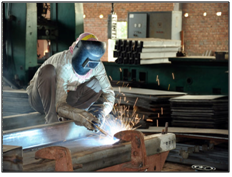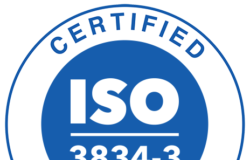
Samir kumar Gupta,
B.E., C.E., FIE., FIIW., MISNT.,MAE.,MITD.
Chartered Engineer, a Life Fellow of the Institution of Engineers (India)
INTRODUCTION
- Today’s economy is Global Economy.
- Global Economy is Global Market Driven.
- Global Markets are dominated by Global Customers.
- Customers are affluent and Quality Conscious.
Manufacturers and producers of goods and services all over the world are very much aware and conscious about the above mentioned axioms and now consciously aligning their Systems of Operation and Products to meet the needs of the customers. Globalization is a process that cuts across national boundaries, integrating and connecting communities in new space-time combinations. As information technology (IT) breaks down the barriers of time and location distinctions are also breaking down between large and small companies. Small, agile firms are now effectively competing with industry giants because IT can make a consortium of small firms look, feel and get big, reaching out for customers once beyond their grasp. This has given rise to intense competition, blurring the boundaries between domestic and global markets. Every commercial organization was earlier focused on making profit only. But now, in addition to making profits or even in order to make profits the objectives of Manufacturing Companies are to be reoriented to satisfy the total needs of the customer who wants:
- Products of consistent high quality.
- Delivery on Time.
- Full amount ordered products at the lowest possible cost level.
World Class Manufacturing [WCM] is the term for the most effective methodologies and techniques to realize some of these objectives but not all. It is increasingly becoming important to understand customers’ needs and wants, and translate these into a unique value-added business mission. Companies capturing and applying information at each point of customer contact will, therefore, be better off than those that do not. Thus, companies have to be able to apply and integrate systems and information technology into the entire product process including research, design, manufacturing, distribution, marketing, and after sales service. Quality is the primary need of all the customers for all the products and services and is the strategic objective that is established to fulfill the needs and expectations of customers and all concerned parties. The quality policy therefore is to exist to shape behavior and establish the core values in an organization and must equate with the corporate policy, no benefits are gained from specifically expressing a quality policy as separate which can not equate with the other corporate objectives, at the same time ignoring other policies. It should be made clear that all policies influencing the behavior must be nourished as key to satisfying the needs of interested parties. To conceptualize the quality policy, a quality management system is to be integrated in the existing management system that will enable the organization to fulfill its purpose and mission. Organizations should have only one system.
THE INTERNATIONAL QUALITY SYSTEMS – ISO 9000
ISO 9000 is an International Standard for formalization of those parts of the existing system that served the achievement of product quality in an organization. ISO 9001 induces organizations to establish a quality system as a means of ensuring product to meet specified requirements. New activities are introduced onto the organization such as management review, internal audit, document control, record control, corrective and preventive action putting in place the necessary linkages to maintain system integrity. The essential elements of the standards are: management responsibility, resource management, quality system, contract review, design control, document control, purchasing, purchaser-supplied product, product identification and traceability, process control. ISO 9000 series is recognized and accepted by all the countries of the world as the valid and proven quality management system for operation and services industries. But, ISO 9000 System cannot certify the capability of a manufacturer using Welding as a main manufacturing process. Within the ISO 9000 series of standards, Welding is to be treated as a “Special Process” since welds cannot be fully verified by subsequent inspection and testing of the product to ensure that the required quality standards have been met. Welding processes and sub processes applied at products manufactured in mass or assembly line productions or job shop productions are numerous. Welding quality is again a feature acceptable to specific customers from a level of whatever quality is produced to six sigma level.
QUALITY REQUIREMENT FOR WELDING – ISO 3834


It is also accepted that “Quality cannot be inspected into product it has to be built into it”. In order to make a welded product free from major defects and to be effective in its use it is necessary to exercise control right from the design stage, through selection of materials, process and methods of manufacture with stipulated inspection and process control stages. Simultaneously, the welding process and procedure have to be correctly formulated and approved. It is needless to point out that skilled supervision is essential for the process, procedure application and inspection. With reference to the quality requirements of welded products, “ISO 3834 Quality Requirements for Welding” has been developed by International Standard Organization in association with the International Institute of Welding as International Welding Quality Assurance Standard (ISO 3834). To ensure the proper quality of welded product and to optimize the manufacturing cost, the whole welding process must be controlled from the very start. To take all welding quality affecting aspects into consideration, the welding shop is recommended to implement a quality assurance system. The standard ISO 3834 sets out requirements for manufacturers to meet, in order to apply good practice to their welding operations. There are several steps in a Welding Quality Assurance; to make sure the welding shop has competent welders, there are standardized ways to test the welders. It is essential to use written welding instructions and/or so called Welding Procedure Specifications (WPS) in order to increase the possibility of consistent quality. The WPS must be qualified, i.e. the WPS has to be based on a WPQR, Welding Procedure Qualification Record. The WPQR explains that, if the WPS is followed, there will have a good chance to weld a joint with the expected properties. The person responsible for welding, or the welding coordinator, in the welding shop, is responsible for the welders’ competence and the education and the management of the welders. The coordinators´ competence requirements, the tasks and responsibilities, are regulated in the standard ISO 14731. In the field of quality management in manufacture and maintenance, the general trend is clearly moving towards a product/process approach. In order to help companies satisfy specific requirements and regional or international product standards, consistently and with regard for the type of product manufactured, IIW has developed specific supplementary guides for the processes/products considered (e.g. railway vehicle components, pressure vessels and construction products), taking into consideration the applicable standards and best practice manufacturing procedures, already shared by the main international manufacturers and customers.
SUMMERISING ISO 3834
- An international standard created by welding professionals.
- A provider of the quality requirements for a welded product, whereas ISO 9001 provides the requirements for a quality management system and it does not establish requirements for welded products, ISO 3834 on the other hand does.
- It specifies requirements relating mainly to the quality of the welded product.
- It encourages a proactive process orientated approach to managing and controlling welding product quality in a workshop or at site.
- It is also a Factory Control System to control activities for the manufacture of the products.
In order to establish such a System and a Standard to be followed uniformly by the European as well as other countries a few rules have been developed following the principle of mutual recognition, which has been agreed between the International Institute of Welding and the European Federation for Welding, Joining and Cutting. Though the EWF Manufacturer Certification System is based on the Management of Quality, Environment and Health and Safety in Welding through the EN ISO 3834 Certification Scheme, the Environment Certification Scheme, the Health & Safety Certification Scheme. The scope of the Agreement between EWF and IIW only includes, for the time being, the management of quality in welding.
MANUFACTURER CERTIFICATION SCHEME (MCS).
Based on the above, the International Institute of Welding (IIW), by virtue of its unique international expertise, has developed an integrated and specialized Certification Scheme to assure companies’ compliance with ISO 3834. This Scheme is referred to as the IIW Manufacturer Certification Scheme according to ISO 3834 (IIW MCS). These Rules establish the mechanism by which the guidelines for the IIW Manufacturer Certification Scheme (MCS) according to ISO 3834 are implemented, such that the requirements are applied uniformly by all countries involved, and that the certificates granted are mutually recognized. This is done by appointing only one organization in each country to act in the name of IIW, and these organizations are assessed and monitored for compliance with the Rules. These organizations are known as the IIW Authorized National Bodies for Company Certification (ANBCCs).The IIW has delegated all authority for this activity to the International Authorization Board (IAB). International Institute of Welding (IIW) has appointed IIW-India through it’s International Authorization Board (IAB) as the accredited Authorized National Body for Company Certification (ANBCC) for the exclusive rights within India to operate its MCS for certification of Companies for compliance to the requirements of ISO 3834. Welding Technology Institute of Australia (WTIA) implemented a Total Welding Management System (TWMS) which incorporates Quality, Occupational Health and Safety plus Environmental Management Systems. The implementation of ISO 3834:2005 Quality requirements for fusion welding of metallic materials forms an integral foundation for the assurance of quality production by a company, with benefits for both bottom-line and local and global competitiveness. WTIA also supports the use of the IIW Manufacturer Certification Scheme (MCS) for the Management of Quality in Welded Fabrication by companies for the implementation of ISO 3834. In Germany, the German Welding Society (DVS) and committees of the German Institute for Standardization (DIN) have accepted the fact that standards alone cannot generate uniform levels of Quality and also established a minimum level of Technology with gradual development process. The Standards followed are DIN EN 3834, DS 952, DIN 6700 and DIN 6701 for EN 15085. ISO 3834 has now become a globally accepted system for Quality Requirement for Welding, for Welded Products manufactured for domestic and international market. Along with ISO 3834 the following Standards are required to be followed for comprehensive application of the System:
- ISO 3834 – Quality Requirements for fusion welding of metallic materials
- ISO 3834-2 Comprehensive Quality Requirements
- ISO 3834-3 Normal Quality Requirements
- ISO 3834-4 Elementary Quality Requirements
- EN 15085 – Railway applications – Welding of railway vehicles and components
- ISO 14731– Welding coordination – tasks and responsibilities
- EN 287-1 – Qualification test of welders – Fusion welding Part1 : Steels
- 606-2-5- Qualification test of welders – Fusion welding (other metallic materials)
- EN 1418 – Approval testing of welding operators
- ISO 15607-15614 – Qualification of welding
The Certification of ISO 3834 Standard Scheme is based on the following set of four documents:
- IAB 337 – IIW Manufacturer Certification Scheme for the Management of Quality in Welding – Interpretation and Implementation of ISO 3834 requirements.
- IAB 338 – IIW Manufacturer Certification Scheme for the Management of Quality in Welding – Guidance for the implementation of ISO 3834 oriented to welded products standard.
- IAB 339 – IIW Manufacturer Certification Scheme for the Management of Quality in Welding – Rules for ANBCC Operating the IIW Manufacturer Certification Scheme.
- IAB 340 – IIW Manufacturer Certification Scheme for the Management of Quality in Welding – ANBCC Assessment of Manufacturers of Welded Products.
The objective is that IIW certified companies will have demonstrated that they have achieved an identified, minimum level of capability over a specified scope of activity, irrespective of the country in which they had been certified.
KEY ELEMENTS CONSTITUTING THE STRUCTURE OF IS0 3834
In order to develop a comprehensive system where nothing or part systems existed the following areas are to be covered to frame the Quality Welding System:
- Review Contract. Design
- Welders, Operators testing and certification (ISO 9606)
- Welding Coordination (EN719)
- Qualification of welding procedures (ISO9956-2)
- Work instructions as per approved WPR
- Procedures for the preparation and control of documents
- Welding consumables: batch testing, storage and control
- Storage of parent materials
- Post weld heat treatment
- Inspection Personnel, inspection, testing and test status
- Non-conformance and corrective actions
- Calibration and validation of measuring, inspection and testing equipment
- Identification and traceability and Quality records
The details of these Standards and their modes of application are essential to learn and put to practice as applicable.
EFFECTIVE USES OF MCS.



Manufacturer of Railway Automotive Industry, Robotic Welding
Coaches and Wagons



Mining Equipment Pipe Line Welding Ships
Engines, Tracks, Bridges, Structurals, Pressure Vessels, Pipe Lines, all small scale ancillary units for welded components and parts for above products, Other industries using welding as main manufacturing process.
PROCEDURE TO OBTAIN ISO 3834 CERTIFICATION
Since the publication of the ISO 9000 family of standards in 1987, and then EN ISO 3834 in 2006 a new industry has grown in its shadow. The industry is characterized by Standards Bodies, Accreditation Bodies, Certification Bodies, Consulting Practices, Training Providers, Software Providers and a whole raft of publications, magazines, web sites and schemes – all in the name of quality! The manufacturer seeking for the Certification of ISO 3834 will have to check the credentials of the Certifying Body before appointing one. After selection of the Certifying body the following steps are to be taken in sequence.
Step1: The manufacturing organisation, in consultation with its customer, reviews the customer’s products and requirements and decides on which of the three levels of quality requirements of ISO 3834 i.e. comprehensive, standard or basic, is appropriate.
Step 2: Establish and implement a welding management system to ISO 3834.“Self assessment of quality requirements – Checklist and action plan” is made available to guide through this process.
Step 3: Request an application form and information pack from Certifying Body.
Step 4: Complete the application form and return it and evidence of any existing certification to the Certifying Body.
Step 5: Based on the information in the application form, a quotation will be sent to the organization by the Accreditation Body / Certifying Body.
Step 6: On receipt of the order from the company the Certifying Body will appoint the assessment team to carry out an assessment.
Step 7: The Lead Assessor sends the appropriate Form 3834 Document Review to the fabricator.
Step 8: The Fabricator completes the document review form and submits this together with the quality management documentation to the appointed assessor, who then carries out a preliminary visit followed by a further review.
Step 9: An on-site audit by the appointed lead assessor(s) is conducted.
Step 10: Part of the audit involves an interview with the responsible welding coordinator.
(One of the criteria for an acceptable RWC is qualification, and the recommended qualifications are IWE, IWT or International Welding Specialist (IWS) in accordance with the International Institute of Welding. Other equivalent qualifications would be considered during the interview stage. If the RWC does not have such a qualification, then someone else within the Manufacturer must, even if that person is an outside Contractor. There must be a direct link between the Contractor and the Manufacturer.)
Step 11: The initial assessment report, a review of any corrective actions and a final report are submitted to the assessor /accredition body.
Step 12: Once the manufacturer has demonstrated compliance to ISO 3834 a certificate from the International Institute of Welding (IIW) for acceptance in the IIW Manufacturer Certification Scheme (MCS) for the Management of Quality in Welded Fabrication will be issued indicating the standard(s) against which certification has been achieved.
Step 13: Surveillance will be carried out annually to demonstrate ongoing compliance
Step 14: Reassessment against ISO 3834 will be required every five years
BENEFITS AND ADVANTAGES OF ISO 3834 CERTIFICATION
Benefits and Advantages for the Manufacturers in getting a certification against the IIW MCS, can be summarized as follows:
- Increased national and international business potential through demonstrated compliance with internationally recognized welding quality requirements
- It will enable the organization as well as the customers to be globally recognized and connected for business.
- Welded products are differently treated according to the specific needs of the welding manufacturing process used.
- Specific areas of competence (for personnel and companies) are explicitly encompassed and registered in the Schedule.
- Manufacturers can get visibility through the Register of Certified Companies.
- Clear, high profile independent verification of its compliance with ISO 3834 requirements.
- Independent confirmation of competence for its welding and fabricating capabilities and staff in a defined scope of activity.
- Welding quality management and fabrication capability assessments carried out by specialist assessors
- As a System is in practice, bottlenecks are few and on the spot decisions can be taken by lower level operators in manufacturing.
- Less rework
- Jobs completed on time
- More efficient coordination of welding activities
- More pro-active and responsible workforce
- Increased opportunities and capability to bid on jobs
- Reduced surveillance audits and inspections by purchasers with significant savings.
- Cost savings – more efficient technology
- Satisfied employer and customer
- Develops team spirit






